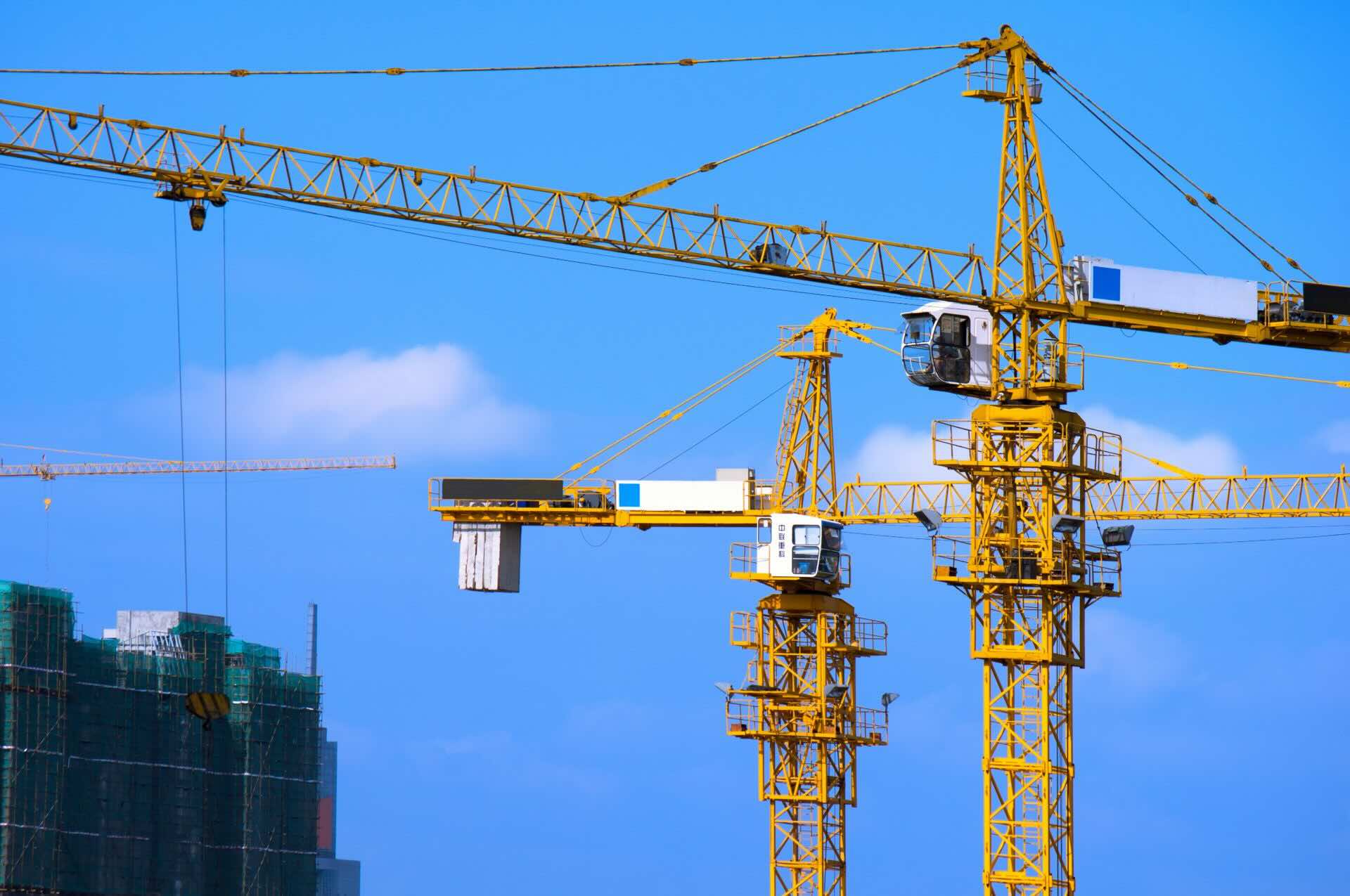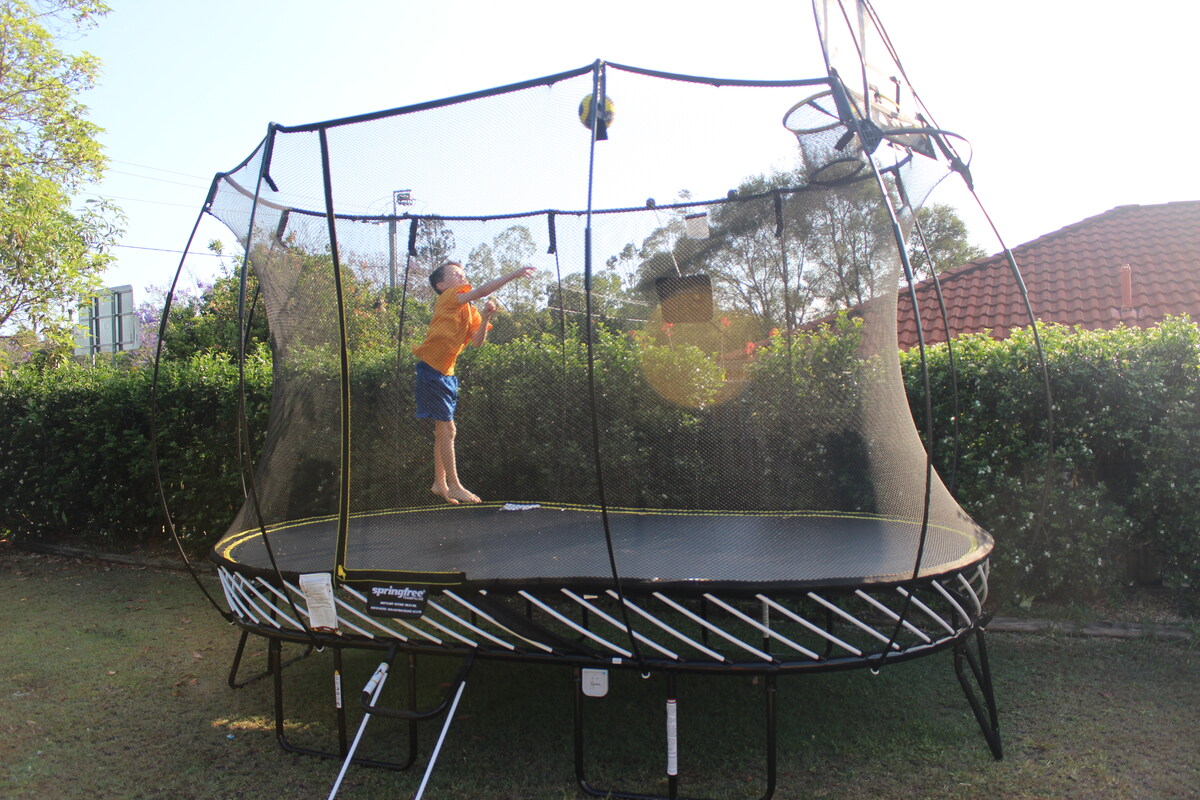Home>diy>Building & Construction>How Construction Cranes Are Assembled


Building & Construction
How Construction Cranes Are Assembled
Modified: January 6, 2024
Learn how building construction cranes are assembled. We explore the step-by-step process, from foundation setup to the final crane assembly.
(Many of the links in this article redirect to a specific reviewed product. Your purchase of these products through affiliate links helps to generate commission for Storables.com, at no extra cost. Learn more)
Introduction
Welcome to the fascinating world of construction cranes! These towering structures are a common sight on construction sites, often marvelled at for their sheer size and capability. Construction cranes play a vital role in the building industry, enabling the efficient movement of heavy materials and equipment.
In this article, we will explore the process of assembling a construction crane, from the initial preparation of the construction site to the final inspection and testing. Understanding the intricacies of crane assembly can provide valuable insights into the complex operations involved in the construction industry.
Whether you’re a construction professional, an engineering enthusiast, or simply curious about the inner workings of these impressive machines, this article will guide you through the step-by-step process of assembling a construction crane.
So, let’s dive into the world of construction cranes and discover how these remarkable structures are put together!
Key Takeaways:
- Assembling a construction crane involves meticulous site preparation, component installation, and rigorous testing. Safety is paramount throughout the process, ensuring the crane is ready to efficiently support construction projects.
- Construction cranes are complex machines with vital components such as the base, mast, boom, jib, and counterweights. Skilled professionals operate these cranes, undergoing rigorous training to ensure safe and efficient construction operations.
Read more: How Are Construction Cranes Assembled
Overview of Construction Cranes
Construction cranes are essential pieces of equipment used in the construction industry to lift and move heavy materials and equipment. They provide a vertical and horizontal reach that allows for efficient movement across construction sites, making them invaluable in the construction of tall buildings, bridges, and other large-scale projects.
These cranes come in various types and sizes, each designed to fulfill specific construction needs. The most common types of construction cranes include tower cranes, mobile cranes, crawler cranes, and overhead cranes. Tower cranes, with their impressive height and lifting capacity, are often seen on high-rise construction projects, while mobile cranes are versatile and can be easily transported to different sites.
Construction cranes consist of several components that work together to perform their tasks. These include the base, mast, boom, jib, hoist, and counterweights. The base provides stability and can be anchored to the ground or mounted on a mobile platform. The mast provides the vertical height, and the boom and jib extend horizontally to reach different areas of the construction site.
In addition to their lifting capabilities, construction cranes are equipped with vital safety features, such as anti-collision systems, load moment indicators, and emergency stop buttons. These features ensure the safety of both the operators and the surrounding workers, making construction sites a safer environment.
Construction cranes are operated by skilled professionals who undergo rigorous training to handle and maneuver these powerful machines. They must be knowledgeable in crane operations, safety procedures, and be able to interpret and follow blueprints and construction plans.
Now that we have a general understanding of construction cranes and their importance in the construction industry, let’s explore the step-by-step process of assembling these towering structures.
Components of a Construction Crane
A construction crane is made up of several key components, each playing a crucial role in its operation. Understanding these components is essential for comprehending the process of crane assembly. Let’s take a closer look at each component:
1. Base
The base of a construction crane provides stability and support for the entire structure. It is either anchored to the ground with concrete foundations or mounted on a mobile platform, such as a truck or crawler tracks. The base is designed to resist the forces generated during crane operations and ensure safe working conditions.
2. Mast
The mast is a vertical tower-like structure that serves as the backbone of the construction crane. It provides the height required for the crane to reach high elevations. Masts are typically made of steel sections called “tower sections” that are stacked on top of each other and secured with bolts. The height of the mast can be adjusted by adding or removing tower sections as needed.
Read more: What Is A Crane In Construction
3. Boom
The boom is the horizontal arm of the crane that extends outwards from the top of the mast. It can be raised or lowered to different angles, allowing the crane to reach various areas of the construction site. Booms are typically made of steel trusses or lattice structures to provide strength and minimize weight.
4. Jib
The jib is an extension of the boom and adds further reach to the crane. It is connected to the end of the boom and can be adjusted in length. The jib allows the crane to reach over obstacles, such as buildings or structures, that may obstruct the direct path of the boom.
5. Hoist
The hoist is responsible for lifting and lowering heavy loads. It consists of a motor, a drum or winch, and a system of ropes or chains. The motor powers the drum, which winds and unwinds the ropes or chains to lift and lower the loads. The hoist is equipped with braking systems to ensure precise control of the load and prevent it from unintentionally descending.
6. Counterweights
Counterweights are crucial for maintaining the balance and stability of the crane. They are typically large, heavy blocks of concrete or steel located at the rear of the crane. Counterweights offset the weight of the loads being lifted by the crane, preventing it from tipping forward.
Read more: How Do Construction Cranes Work
7. Controls and Cab
At the top of the mast, there is a cab where the crane operator controls the crane’s movements. The cab is equipped with various controls, including joysticks, pedals, and switches. These controls allow the operator to operate the crane’s functions, such as lifting, lowering, swinging, and extending the boom and jib.
By understanding the components of a construction crane, we can now move on to the process of assembling these components and bringing the crane to life on a construction site.
Preparing the Construction Site
Before the assembly process can begin, it is essential to prepare the construction site to ensure a safe and efficient crane installation. Here are the key steps involved in site preparation:
1. Site Survey
Firstly, a thorough site survey is conducted to assess the ground conditions and determine the best location for the crane. This survey helps identify any obstacles, such as power lines, trees, or nearby structures, that could interfere with the crane’s operation. It also helps determine the size and type of crane that can be accommodated on the site.
2. Clearing and Leveling
Once the survey is complete, the construction site is cleared of any debris, vegetation, or obstructions. It is essential to create a level and stable surface for the crane’s base. Grading and leveling might be required to ensure the ground is even and capable of supporting the crane’s weight and load requirements.
Read more: How Do Construction Cranes Go Up
3. Access Routes
Next, access routes are planned and prepared to facilitate the movement of the crane and its components. These routes should be wide enough and free from any hindrances to allow the transportation of the crane parts safely. It may involve removing obstacles, reinforcing weak spots, or creating temporary roads or pathways.
4. Safety Measures
Prioritizing safety is crucial during site preparation. Safety measures are implemented, including the installation of temporary fencing or barriers to restrict unauthorized access to the crane assembly area. Warning signs and hazard markings are placed to alert workers and visitors to potential dangers. Safety protocols, such as wearing personal protective equipment (PPE), are emphasized to ensure a safe working environment.
5. Utilities and Services
Before crane assembly can begin, utilities and services such as power, water, and communication lines need to be identified and properly marked. This is to ensure that these services are not disrupted during the construction process and that the crane installation does not cause any damage or interference.
By following these preparatory steps, the construction site is ready for the assembly of the crane. With a cleared and leveled area and adequate safety measures in place, the process of assembling the crane’s base and mast can commence.
Assembling the Base and Mast
Once the construction site has been prepared, the process of assembling the construction crane begins with the installation of the base and mast. Here are the step-by-step instructions for this crucial phase:
Read more: How To Assemble A Kegerator
1. Positioning the Base
The base of the crane is carefully positioned in the designated location on the construction site. If the crane is anchored to the ground, concrete foundations are prepared in advance and the base is secured using anchor bolts. If it is a mobile crane, it is positioned on its respective mobile platform, such as a truck or crawler tracks.
2. Securing the Base
Using hydraulic jacks or other lifting equipment, the base is raised and leveled. This ensures that the crane will be stable and balanced during operation. Proper alignment and leveling are crucial to prevent any stress or strain on the crane components and ensure safe and efficient functioning.
3. Erecting the Mast
Once the base is secured, the mast sections are lifted into place using a crane or mechanical lifting equipment. Each mast section is carefully aligned and connected to the previous section, using bolts to secure them together. The height of the mast is determined by the number of sections used, depending on the desired reach and capacity of the crane.
4. Bolting the Mast
As each mast section is connected, specialized construction personnel ensure that they are properly aligned and plumbed to maintain the verticality of the crane. Bolts are then inserted and tightened to secure the sections tightly together. Torque wrenches or other tools are used to ensure the proper tightening of the bolts.
Read more: How To Assemble A Pergola
5. Checking for Stability
Once the mast is fully assembled, the crane’s stability is checked to ensure it meets the safety standards. The construction crane should display minimal deflection and should not sway or wobble excessively. Any signs of instability are immediately addressed and rectified to ensure a safe working environment.
With the base and mast successfully assembled, the construction crane begins to take shape. The next step involves the installation of the boom and jib, which will provide the necessary reach and flexibility for the crane’s operations.
Installing the Boom and Jib
Once the base and mast of the construction crane are securely assembled, the next step in the process is to install the boom and jib. These components give the crane its horizontal reach and versatility. Let’s explore the installation process in detail:
1. Preparing the Boom Sections
Before installing the boom, the individual sections are inspected to ensure their structural integrity and proper functioning. Any damage or defects are addressed, and the sections are cleaned and prepared for installation.
2. Hoisting the Boom Sections
Using a separate crane or the crane’s own hoisting mechanism, the boom sections are carefully lifted into position. Each section is aligned and connected to the previous one, usually by bolting or pinning them together. The number of boom sections required depends on the desired length and reach of the crane.
Read more: How To Clean A Crane Humidifier
3. Connecting the Jib
Once the boom is successfully installed, the jib is connected to its designated position at the end of the boom. The jib, which extends the reach of the crane further, is attached using pins or bolts, ensuring a secure connection.
4. Checking Alignment and Functionality
Once the boom and jib are in place, thorough checks are conducted to ensure proper alignment and functionality. Any necessary adjustments are made, and the bolts, pins, or other connecting mechanisms are tightened to ensure stability and safety during crane operations.
5. Testing the Movement
After the installation, a series of controlled tests are performed to verify the movement of the boom and jib. The crane operator will test their range of motion, ensuring that they can be raised, lowered, and extended smoothly and without any obstructions or restrictions.
By installing the boom and jib, the construction crane gains its essential horizontal reach and flexibility. These components enable the crane to maneuver and lift loads across different areas of the construction site. The next step involves attaching the necessary counterweights to ensure the crane’s stability during operation.
Attaching the Counterweights
Counterweights are an integral part of a construction crane as they provide balance and stability during lifting operations. Attaching the counterweights is a critical step in the crane assembly process. Let’s delve into the details of this important task:
Read more: How To Assemble A Dresser
1. Determining the Counterweight Requirement
The counterweight required for a construction crane depends on various factors, such as the crane’s lifting capacity, boom length, and the load it is designed to handle. Engineering calculations are performed to determine the precise weight needed to counterbalance the loads being lifted.
2. Positioning the Counterweights
The counterweights are typically large and heavy concrete or steel blocks. These blocks are strategically placed at the rear of the crane, either on a counterweight tray or secured to the crane structure. The counterweights are positioned in a way that offsets the weight of the lifted loads and prevents the crane from tipping forward during operation.
3. Securing the Counterweights
Once the counterweights are in position, they are carefully secured to prevent any movement or displacement. This is usually done using bolts, pins, or other fastening mechanisms. It is crucial to ensure the counterweights are securely attached to maintain stability and safe crane operations.
4. Checking Balance and Stability
After the counterweights are attached, tests are conducted to check the balance and stability of the crane. This includes monitoring the crane’s response to various movements and verifying that it remains balanced during simulated lifting operations. Any adjustments needed to achieve optimal balance are made to ensure safe and efficient crane performance.
Read more: How To Assemble Dining Chairs
5. Engineering and Safety Checks
Before the crane can be put into service, engineers and safety personnel conduct thorough inspections and tests. They verify that the counterweights meet design specifications, perform load calculations, and ensure that all safety measures, such as load moment indicators and anti-tipping systems, are functioning correctly.
By attaching the counterweights, the construction crane achieves the necessary balance to safely lift and maneuver heavy loads. With the base, mast, boom, jib, and counterweights in place, the final steps involve installing the crane’s cab and controls, allowing for the operation of the crane from an elevated position.
Installing the Cab and Controls
The installation of the crane’s cab and controls is a crucial step in the assembly process, as it allows the crane operator to safely and efficiently control the crane’s movements. Let’s explore the process involved in installing the cab and controls:
1. Positioning the Cab
The crane’s cab is typically located at the top of the mast, providing an elevated vantage point for the operator. The cab is carefully positioned and secured, ensuring a stable and safe environment for the operator to oversee the crane’s operations.
2. Mounting the Controls
The crane’s controls, which include joysticks, switches, and pedals, are mounted within the cab. These controls allow the operator to manipulate the crane’s movements, such as lifting, lowering, swinging, and extending the boom and jib. They are strategically placed to provide ease and comfort for the operator in operating the crane’s functions.
Read more: How To Assemble A Coffee Table
3. Electrical Connections
Electrical connections are made within the cab to ensure the proper functioning of the crane’s controls. This includes connecting control wires and cables to the corresponding components of the crane, such as the motors, brakes, and safety systems. Electrical connections are made following industry standards and safety guidelines to ensure reliable and safe operation.
4. Testing the Controls
After the installation, comprehensive tests are performed to ensure the smooth and accurate functioning of the crane’s controls. The operator tests the controls and verifies their responsiveness and precision in executing the desired crane movements. Any issues or malfunctions are identified and resolved before proceeding with the next steps.
5. Operator Training
Once the cab and controls are installed and deemed operational, it is essential to provide comprehensive training to the crane operator. The operator should be familiarized with the various controls, safety features, and operational procedures specific to the crane model. Training ensures the operator’s competence in handling the crane efficiently and safely.
With the cab installed and the controls in place, the construction crane is now ready for final testing and inspection to ensure its compliance with safety regulations and industry standards. Let’s explore these important steps in the assembly process.
Testing and Inspecting the Crane
Testing and inspecting the construction crane is a crucial final step in its assembly process. This ensures that the crane is safe, efficient, and fully-functional before it is put into operation on the construction site. Let’s explore the detailed procedures involved in testing and inspecting the crane:
Read more: How To Assemble A Dining Table
1. Load Testing
One of the critical tests performed on the crane is a load test. This involves applying a known weight to the crane’s hook and lifting it to verify that the crane can handle the specified load safely. Load tests are conducted with different load capacities and at various boom lengths to ensure the crane’s lifting capabilities meet the required standards.
2. Functionality Testing
The crane’s functionality is thoroughly tested to ensure that all its modes of operation are working as intended. This includes testing the crane’s ability to hoist, lower, swing, extend, and retract the boom and jib smoothly and efficiently. The controls, brakes, safety features, and emergency systems are all tested for proper functionality.
3. Inspecting Mechanical Components
A comprehensive inspection of the crane’s mechanical components is conducted to identify any signs of wear, damage, or malfunction. This includes inspecting the cables, chains, pulleys, sheaves, and other moving parts for any signs of fatigue, rust, or excessive wear. Any faulty components are repaired or replaced to ensure optimal performance.
4. Electrical System Inspection
The electrical system of the crane is thoroughly inspected to ensure proper insulation, grounding, and overall functionality. This includes examining the wiring, motor controls, safety sensors, and emergency stop systems. Proper grounding of the crane is essential to protect against electrical hazards and ensure safe operation.
Read more: How To Assemble A Nostalgia Kegerator
5. Safety Inspection
A detailed safety inspection is conducted to ensure compliance with safety regulations and industry standards. This involves checking safety features such as load moment indicators, anti-collision systems, and emergency stop buttons. Any necessary adjustments or enhancements are made to guarantee the crane’s safe operation on the construction site.
6. Documentation and Certification
Once the crane has successfully passed the testing and inspection processes, documentation is prepared to certify its compliance with regulations and standards. This includes maintaining records of load tests, inspection reports, and certifications of the crane’s components. The documentation is essential for regulatory compliance and future maintenance purposes.
By conducting rigorous testing and inspection, the construction crane undergoes a thorough assessment to ensure that it is safe, reliable, and ready for operation. With the completion of these final steps, the crane is now ready to contribute to the construction project, enabling the efficient movement of heavy materials and equipment.
Conclusion
Assembling a construction crane is a meticulous process that requires careful planning, skilled labor, and adherence to safety guidelines. From preparing the construction site to the final testing and inspection, each step in the assembly ensures that the crane is safe, functional, and ready to tackle the demands of the construction industry.
We explored the various components of a construction crane, including the base, mast, boom, jib, counterweights, cab, and controls. Each component plays a vital role in the crane’s operation, providing the stability, reach, and lifting capabilities necessary for construction projects of all sizes.
Throughout the assembly process, safety is of utmost importance. Site preparation ensures a secure and hazard-free environment for the crane’s operations. Rigorous testing and inspection procedures verify the crane’s functionality, mechanical integrity, and compliance with safety regulations and industry standards.
Construction cranes are instrumental in the construction industry, facilitating the movement of heavy materials and equipment, and enabling the construction of impressive structures. They are operated by skilled professionals trained in crane operations, safety protocols, and interpreting construction plans.
As the crane assembles piece by piece, it transforms from a collection of components into a powerful and efficient machine. The construction crane becomes a symbol of the industry’s ingenuity and the relentless pursuit of progress.
In conclusion, the assembly of a construction crane requires expertise, precision, and a commitment to safety. By understanding the intricacies of crane assembly, we gain a deeper appreciation for the remarkable machines that drive the construction industry forward, making our cities taller, safer, and more advanced.
Frequently Asked Questions about How Construction Cranes Are Assembled
Was this page helpful?
At Storables.com, we guarantee accurate and reliable information. Our content, validated by Expert Board Contributors, is crafted following stringent Editorial Policies. We're committed to providing you with well-researched, expert-backed insights for all your informational needs.





0 thoughts on “How Construction Cranes Are Assembled”